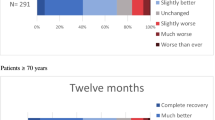Abstract
Purpose
The Myelopathy Disability Index and the Neck Disability Index are widely used to assess outcome in cervical spine surgery. Short Form (SF) 36 is a generic measure of health which can be used to measure health gains across a wide variety of conditions. The aim of the current study is to assess long-term outcomes using these measures in a cohort of patients with cervical spondylotic myelopathy (CSM).
Methods
Cohort study with prospective data collection. Patients with CSM being offered decompressive surgery were asked to complete a set of generic and condition-specific outcome measures. This was repeated post-operatively at 3, 12, 24 and 60 months. SF-36 was used as a generic outcome measure and the Myelopathy Index, Neck Disability Score and visual analogue scores for arm, neck and hand pain, paraesthesia and dysthaesia were used as condition-specific outcome measures.
Results
Significant improvements in all outcome measures were seen in 70 % of the cohort. For SF-36, pre-operative scores were lower than age-matched controls in all domains and significant improvements were seen 3 months following surgery. This improvement in outcome was maintained at 5 years follow-up in approximately two-thirds of those with initial improvement.
Conclusion
We have used generic and condition-specific outcome measures of health and shown that in patients with CSM treated surgically, up to 70 % can expect improvement in their quality of life. These outcome measures are easy to collect and provide objective evidence of changes in quality of life and disability and can help quantify the potential health gains that can be achieved.






Similar content being viewed by others
References
King JT Jr, Moossy JJ, Tsevat J, Roberts MS (2005) Multimodal assessment after surgery for cervical spondylotic myelopathy. J Neurosurg Spine 2(5):526–534
Geigle R, Jones SB (1990) Outcomes measurement: a report from the front. Inquiry 27(1):7–13
Jankowitz BT, Gerszten PC (2006) Decompression for cervical myelopathy. Spine J 6(6 Suppl):317S–322S
Latimer M, Haden N, Seeley HM, Laing RJ (2002) Measurement of outcome in patients with cervical spondylotic myelopathy treated surgically. Br J Neurosurg 16(6):545–549
Ebersold MJ, Pare MC, Quast LM (1995) Surgical treatment for cervical spondylitic myelopathy. J Neurosurg 82(5):745–751
Casey AT, Bland JM, Crockard HA (1996) Development of a functional scoring system for rheumatoid arthritis patients with cervical myelopathy. Ann Rheum Dis 55(12):901–906
Singh A, Crockard HA (2001) Comparison of seven different scales used to quantify severity of cervical spondylotic myelopathy and post-operative improvement. J Outcome Meas 5(1):798–818
King JT Jr, McGinnis KA, Roberts MS (2003) Quality of life assessment with the medical outcomes study Short Form-36 among patients with cervical spondylotic myelopathy. Neurosurg 52(1):113–120 (discussion 121)
King JT Jr, Roberts MS (2002) Validity and reliability of the Short Form-36 in cervical spondylotic myelopathy. J Neurosurg 97(2 Suppl):180–185
King JT Jr, Tsevat J, Moossy JJ, Roberts MS (2004) Preference-based quality of life measurement in patients with cervical spondylotic myelopathy. Spine (Phila Pa 1976) 29(11):1271–1280
Rajshekhar V, Muliyil J (2007) Patient perceived outcome after central corpectomy for cervical spondylotic myelopathy. Surg Neurol 68(2):185–190 (discussion 190–181)
Stoffman MR, Roberts MS, King JT Jr (2005) Cervical spondylotic myelopathy, depression, and anxiety: a cohort analysis of 89 patients. Neurosurg 57(2):307–313 (discussion 307–313)
Thakar S, Christopher S, Rajshekhar V (2009) Quality of life assessment after central corpectomy for cervical spondylotic myelopathy: comparative evaluation of the 36-Item Short Form Health Survey and the World Health Organization Quality of Life-Brief. J Neurosurg Spine 11(4):402–412
Zigmond AS, Snaith RP (1983) The Hospital Anxiety and Depression Scale. Acta Psychiatr Scand 67(6):361–370
Conflict of interest
None.
Author information
Authors and Affiliations
Corresponding author
Rights and permissions
About this article
Cite this article
Al-Tamimi, Y.Z., Guilfoyle, M., Seeley, H. et al. Measurement of long-term outcome in patients with cervical spondylotic myelopathy treated surgically. Eur Spine J 22, 2552–2557 (2013). https://doi.org/10.1007/s00586-013-2965-4
Received:
Revised:
Accepted:
Published:
Issue Date:
DOI: https://doi.org/10.1007/s00586-013-2965-4




